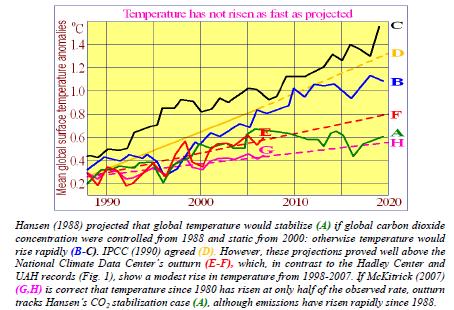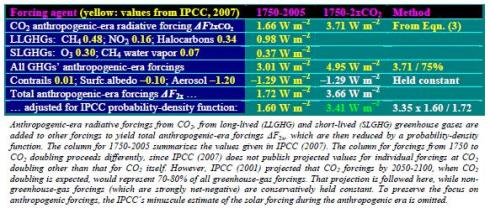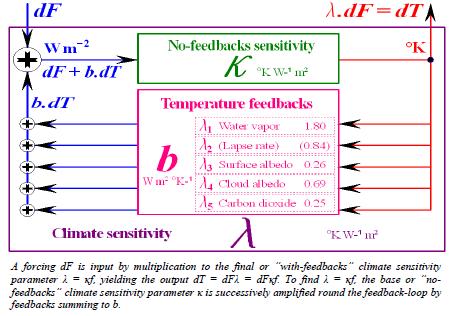Albedo and OLR Radiation with Variations of Precipitation – Implications for AGW
March 9, 2011
By William M. Gray & Barry Schwartz
March 3, 2011
INTRODUCTION
Global warming scenarios from CO2 increases are envisioned to bring about rainfall enhancement and resulting upper troposphere temperature and water vapor increases. The initial warming resulting from the blockage of infrared (IR or OLR) radiation due to CO2’s increases has been programmed in climate models to develop yet additional rainfall, temperature, and water vapor increases. This causes an additional blockage of IR energy to space which is substantially larger than the original CO2 blockage of IR by itself. This additional longwave IR blockage of energy to space (a positive feedback mechanism) is simulated in the models to be twice or more as strong as the original IR blockage from CO2 alone. We question the reality of this positive feedback mechanism. This study is directed towards determining the reality of such large positive feedback processes. This is a crucial question for determining the likely amount of global warming that will result from the anticipated doubling of CO2 by the end of the 21st century.
We have analyzed a wide variety of albedo and IR differences which are associated with rainfall variations on many different space and time scales. Our goal is to determine the extent to which we are able to accept or reject the reality of the Global Climate Model (GCM) simulations. The following analysis indicates that the GCM simulation of the influence of a doubling of CO2 give far too much global warming. We anticipate that a doubling of CO2 will act in a way to cause the global hydrologic cycle to increase in strength by approximately 3-4 percent. Our analysis indicates that there will be very little global temperature increase (~0.3oC) for a doubling of CO2, certainly not the 2-5oC projected by the GCMs.
DATA ANALYSIS
We have analyzed 21 years (1984-2004) of ISCCP (International Satellite Cloud Climatology Project) outgoing solar (albedo) and IR (OLR) on various distance (from local to global) and time scales (from daily to decadal). We have investigated how radiation measurements change with variations in precipitation as determined from NCEP-NCAR reanalysis data on a wide variety of space and time scales (Figure 1). We have stratified our radiation and rainfall data into three latitudinal sections and six longitudinal areas (Figure 2). We analyzed IR and albedo changes which were related to reanalysis-determined rainfall variations by month (January to December) and by yearly periods for the tropics (30oN-30oS; 0-360o) and for the globe, defined as 70oN-70oS; 0-360o for this study.
For each month and region we have categorized our 21 years of ISCCP radiation data into the 10 highest average monthly rainfall values and subtracted the 10 lowest average monthly rainfall values. We analyzed IR and albedo differences between these 10 highest versus 10 lowest precipitation months. These monthly rainfall differences were typically between 4-7 percent of the total rainfall. For the 10 highest minus 10 lowest yearly rainfall differences within the tropics (30oN-30oS; 0-360o) and for most of the globe (70oN-70oS; 0-360o), rainfall differences varied between 2-3 percent.
A second rainfall stratification involved comparing the rainfall and associated IR and albedo differences for variations in rainfall for the years of 1995-2004 versus the years of 1984-1994. The latter 10 years had approximately two percent more tropical and global rainfall than the earlier period. The individual monthly differences for the earlier and latter period were in the range of 3-4 percent of the mean rainfall values.
The third rainfall stratification involved daily mean rainfall and its association with IR and albedo at many individual stations. We also analyzed 3-hourly radiation information associated with daily average rainfall differences. Our individual 3-hour albedo analysis showed that albedos can be as high as 800-1000 Wm-2 over heavy rain and cloud regions near mid-day.
FINDINGS
a) The albedo occurring over the top of strong precipitation and high cloud regions typically increases at a greater rate than does the usual decrease of IR within these same rain and cloud areas. Heavy rain and cloud areas are local places of strong enhanced net radiation to space (Figure 3 – left diagram). In almost all organized rain and cloud areas we find that albedo to space goes up in both magnitude (Wm-2) and in percentage more than the expected simultaneous magnitude and percentage reduction of IR flux to space.
In the adjacent subsidence areas of little or no cloudiness and rain there is typically a reduction of albedo that is one to two times greater than the enhancement of IR to space (right side of Figure 3). In scattered and broken cloud areas of little or no significant rain there is typically a close balance between the enhancement of IR to space and the reduction of albedo.
b) IR and albedo usually change in opposite directions. They have a high negative correlation. There are places and times however, where IR and albedo change together to either enhance or to suppress outward radiation flux.
c) The typical enhancement of rainfall and updraft motion in the cumulus and cumulonimbus clouds within heavy raining meso-scale disturbance areas acts to increase the return flow subsidence in the surrounding broader clear and partly cloudy regions (Figure 4). Global rainfall increases typically cause an overall reduction of specific humidity (q) and relative humidity (RH) in the upper and middle tropospheric levels of the broader scale surrounding subsidence regions. This leads to a net enhancement of IR to space, both over the tropics and the globe. Albedo is typically decreased as much or more than IR is increased in the broadscale clear and partly cloudy areas. But over the rainy and cloudy areas, the albedo is greatly enhanced. The albedo enhancement over the cloud-rain areas tends to increase the net (IR + albedo) energy to space more than the weak suppression of (IR + albedo) in the clear and partly cloudy areas.
d) We observe that upper level RH and moisture content (q) at 300 mb (~10 km) and 400 mb (~8 km – not shown) are typically reduced for increasing amounts of net tropical rainfall. This is a direct consequence of the slightly greater return flow mass subsidence coming from the smaller areas of strong and concentrated updrafts of the deep cumulonimbus (Cb) rainclouds. This lowering of upper-level water vapor over the broad subsidence areas slightly increases the optical depth (τ) and slightly lowers the radiation emission level to a warmer layer where more IR energy is able to be radiated to space.
The NCEP reanalysis data shows that there has been a steady decrease in upper tropospheric RH over the last 40 years (Figure 6). ISCCP data for the tropics show a small decrease in precipitable water (PW) since the mid 1980s (Figure 7). We do not find that net tropospheric water vapor content is necessarily related to rainfall rate. Increases in tropical and/or global rainfall typically lead to decreases in upper tropospheric water vapor content. This is in contrast with the general assumption of most climate scientists who believe that as global rainfall increases that tropospheric water vapor content will have to rise. This thinking fails to take into account the nature of the small-scale cumulus convective units. With the proper convective cloud model it is quite plausible that upper tropospheric moisture undergoes a decrease as tropical and/or global rainfall rates go upward. A long observational paper is presently being prepared to more fully document our many observations of the association of changes of rainfall with albedo and IR.
4. IMPLICATIONS OF THESE OBSERVATIONS
The above measurements are at odds with the GCM simulations of precipitation increase associated with rising CO2 amounts. Most GCMs show large upper tropospheric tropical temperature and water vapor increases to be associated with increased rates of precipitation. We do not observe such upper tropospheric temperature and moisture gains with rainfall enhancement. The GCM simulations assume that CO2’s blockage of IR stimulates an enhancement of extra rainfall which causes yet larger increases in upper level temperature-moisture and consequently causes stronger reductions in IR energy to space. These assumptions require the models to impose an increase in water vapor (to keep RH constant) as upper level temperature gains occur. We do not observe such upper-level temperature and moisture rises. We do not find that upper tropospheric temperature and RH are necessarily related to each other as the GCMs typically assume. We also do not find that upper and lower tropospheric water vapor amounts are strongly correlated with one another as the GCMs do.
It is possible for the troposphere to gain energy from increases in CO2 and to simultaneously enhance its radiation to space to largely balance out all or most of the CO2 energy gains. Such a compensation will allow CO2 to increase with very little or no gain in tropospheric temperature. Such energy compensation can occur by CO2 increases causing a lowering of the radiation emission level to a warmer temperature and thereby increasing the outward IR (σT4) flux to space. The energy compensation can also occur by assuming that the CO2-induced extra cloudiness-rainfall causes a compensating rise in albedo. Or, the CO2-induced blockage could be compensated for (as the GCMs have chosen to do) by having upper tropospheric temperature rise by amounts of 3-4oC or more. Our observations suggest that such an upper-level warming and consequent moistening process due to rising levels of CO2 does not occur.






